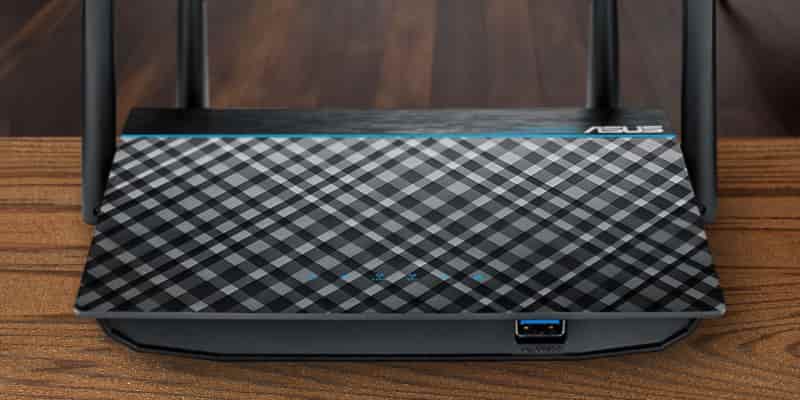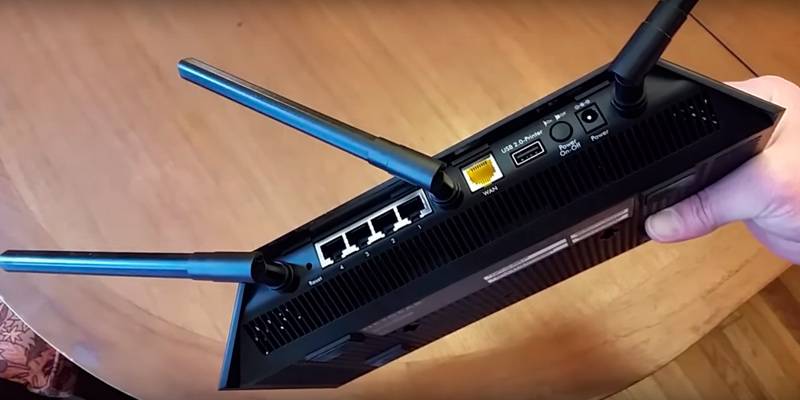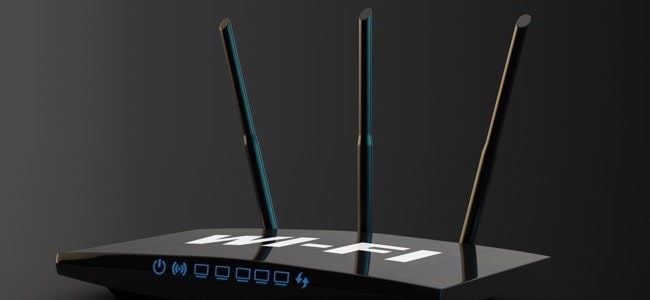Overview
Key features
| Antenna | 4 |
|---|---|
| Bands: | 2.4 GHz: 400 Mbps/5 GHz: 867 Mbps |
| LAN Ports | 4 x 10/100/1000M |
| Other ports | 1 x USB 3.0 |
The RT-ACRH13 is an upgrade from the RT-AC66U, and very much focused on the average consumer. Instead of going for ridiculously high theoretical throughput like 3200 Mbps or 4500 Mbps, Asus instead focused on delivering stable performance at longer distances. Granted, the 1300 Mbps theoretical max might not seem high, but with real-world performance requiring much less than that, depending on your package, it’s not a deal-breaker at all.
More than that, though, is that it offers this really good performance at a really good price, and makes mid-to-high-end routers more accessible to the average consumer. It also keeps complexity down and hands to you all the tools you need to tweak and configure it according to your needs.
Asus RT-ACRH13 Performance
The Asus RT-ACRH 13 comes packed with a bunch of internal hardware. For starters, it has a 717 Mhz Qualcomm processor, 128 MB of internal flash memory and 128 MB of ram all of which add on to the quality and performance of the router. As you’ve probably noticed, it also comes with four arranged in 2×2 – meaning it’s an awesome dual-band router for gaming.
Theoretical speeds are 500 Mbps at 2.4 GHz and 867 Mbps at 5 GHz for a total of 1267 Mbps, although it generally gets rounder to 1300 Mbps. Of course, if you’ve read any router reviews before, you’ll know that the theoretical rarely ends up being the reality. Instead, you’re going to be looking at much lower speeds, although still relatively high considering the average internet package a person could have.

At a close range of around 5 or 6 feet, you’ll see 2.4 GHz performance be around 100 Mbps and roughly 445 Mbps on the 5 GHz band. Moving out to 15-20 feet, 2.4 GHz performance drops slightly to 80 Mbps and 5 GHz dropped a bit more significantly to 325 Mbps. Finally, moving to around 100 feet, 2.4 GHz drops massively to 20 Mbps and the same goes for 5 GHz which drops to 130 Mbps.
Now, you might think that those numbers aren’t great, but a combined speed of 150 Mbps at 100 feet is actually pretty excellent when you think about how ridiculously far away that is. It manages those speeds at those distances mostly due it’s beamforming technology, which instead of broadcasting the signal in every direction at the same time, it instead scans and finds the direction of specific devices and sends the signal along a beam to that device. So yeah, it’s some pretty powerful tech that’s helped all the more by the internal hardware that we mentioned before.
Asus RT-ACRH13 Bonus Features
Another thing which certainly helps keep throughput high, is MU-MIMO, pretty new technology in the wireless router industry. Essentially what it does is that it allows the router to serve multiple devices at the same time, both in and out, rather than doing a round-robin or ‘tokens’ system where each device is served one after the other. Since the router can serve multiple devices at the same time, latency isn’t as big of a problem as it would be with a round-robin system.
Given all the above, gaming and streaming performance is really excellent, even if you’re at quite a distance from the router. You probably won’t have to worry about too many dead spots, given the beamforming, so you should feel comfortable gaming or streaming wherever you are in your house.
Finally, storage performance is reasonably ok but not that great, with file transfer speeds of 25 Mbps reading from the storage device and 20 Mbps while writing to it.
Asus RT-ACRH13 Design
I have to say, in terms of looks the Asus RT-ACRH13 does a really good job of looking snazzy. The black/white/grey diamond pattern on the top looks really nice, almost like plaid, and you don’t usually see manufacturers going for this kind of design, so it really stands out. The antennas are also arranged pretty nicely; instead of being symmetrically put around the router, they’ve put two in the back and two on the sides, so the front of the router isn’t messy or full of antennas.

That’s pretty useful since the USB 3.0 port is on the front, so you don’t want things getting in the way of that. The top portion with the plaid design actually extends over and out from the main body of the router, giving it a little lip to the front and sides which adds a little bit of protection to the USB port as well as the two side antenna. This might seem like a minor detail but if you live with kids or people who aren’t 100% careful of things, it’s nice to have that little extra protection.
Asus RT-ACRH13 Connectivity
In terms of mounting, the RT-ACRH13 has two mounting holes in the bottom if you want to stick it up on a wall. Otherwise, you can put it down flat as you see and it has four rubber feet at the bottom to keep it safe and stable. Just keep in mind if you keep it on your desk the antenna will take up a bit of space, so make sure to account for that.
The indicator LEDs are minimalist and hidden in the plaid design of the router. You get six of them in total; power indicator, WAN, 2.4 GHz, 5 GHz, USB device and LAN connections. I actually like having a larger amount of diagnostic LEDs so I can get an idea of what’s going on at a glance, although some might find that it’s too many LEDs overall.

On the back, you get the standard suite of ports and buttons; 4 X LAN, 1 x WAN, 1 x Power Button, and 1 x WPS button.
Asus RT-ACRH13 Interface
Finally, looking at the interface and web-app called AsusWRT, it’s reasonably compact and well designed. Initial setup is relatively hassle-free and when you first log in it prompts you to go through the wizard where it will auto-detect your connection type and you’ll insert SSIDs. It’s pretty easy and doesn’t make you feel too overwhelmed with information.
The same might not necessarily be said for the full app, but if you’re familiar with router interfaces it shouldn’t be too difficult. You get a variety of menus to choose, from network mapping to traffic monitor. You can also access the interface through Android or iOS through the AiCloud mobile app, a feature that is super handy.
Asus RT-ACRH13 Pricing & Alternative
You can currently buy the Asus RT-ACRH13 for $69.99, a pretty good price for what you’re getting out of the box. You should be aware that there’s a similar device by Asus on the market, the RT-AC66U. It’s essentially the same case but with three antennae rather than two. The RT-AC66U is pretty much the older model, so you want to go for the RT-ACRH13.

As for alternatives, there’s a couple of pretty good ones. The NETGEAR R6700 Nighthawk AC1750 is a bit of a step up from the RT-ACRH13 although it does come at a slightly higher price (which is to be expected). Another great option is TP-LINK Archer A7 AC1750 which has roughly the same performance as the RT-ACRH13 but with a different look, although their prices are similar.
Asus RT-ACRH13 FAQ
What does AC1300 mean?
The ‘AC’ in the title means that the router supports the latest networking standard: 802.11ac (notice the ‘ac’ at the end of the standard’s name). The number after the AC is the maximum theoretical throughput or speed, the router is capable of. In this case, 1300 Mbps.
Another example is something like AC1750 which you’ve seen above. That means the router supports 802.11ac and is capable of a maximum speed of 1750 Mbps.
Is AC better than N?
Absolutely, it’s much better. AC has a higher theoretical maximum at 13. Gbps while the N only has a maximum of 450 Mbps. Also, AC can handle up to 100 users compared to the 40 or so that N can support while being stable.
Will AC router work with N devices?
Yes, absolutely! 802.11ac is backward compatible 802.11b, g, and n, so you shouldn’t have any issues running your new router with an older device.

If you decide on another great gaming router, we advise you first check the compatibility.
Which WiFi channel is best?
The answer to this is basically the same as asking which road is the best to take: the one with the least amount of people. So if you see that one channel has more traffic than others, switch to the ones with less traffic.
Does my computer support 5GHz?
Most modern-day computers should support 5GHz, but, just to be sure, you can follow Buffered VPN’s article on how to check if your computer supports 5Ghz WiFi.
Do WiFi routers wear out?
Of course, like any electronic device, it will begin to wear out at some point. You should expect your router to last at least 3-5 years (which is pretty standard for electronics). That doesn’t mean your device will suddenly fail after 5 years, it only means that’s the point where it’s more likely to start failing than not.
Final Verdict
The RT-ACRH13 is a router which knows what you need and delivers it in a small package with a great price. With its MIMO and beamforming technologies, it can offer relatively fast speeds at long ranges, even compared to higher-end models. On top of that, it’s packed with features and it looks great to boot.
You’ve probably heard of remarkable ASUS laptops which prove the high standard of quality this company is pursuing. When it comes to routers, it’s no different. ASUS RT-ACRH13 is probably one of the better routers out there if you’re aiming for an awesome gaming router under $100 and I’d certainly recommend it as a purchase.